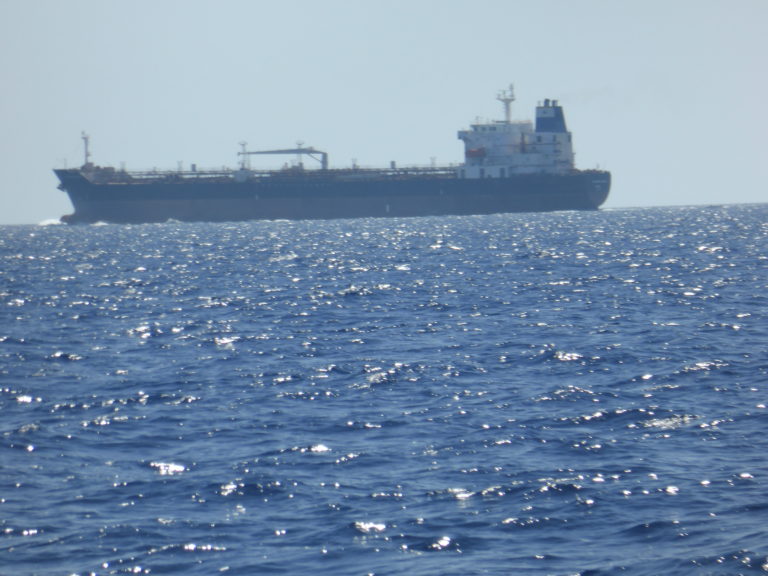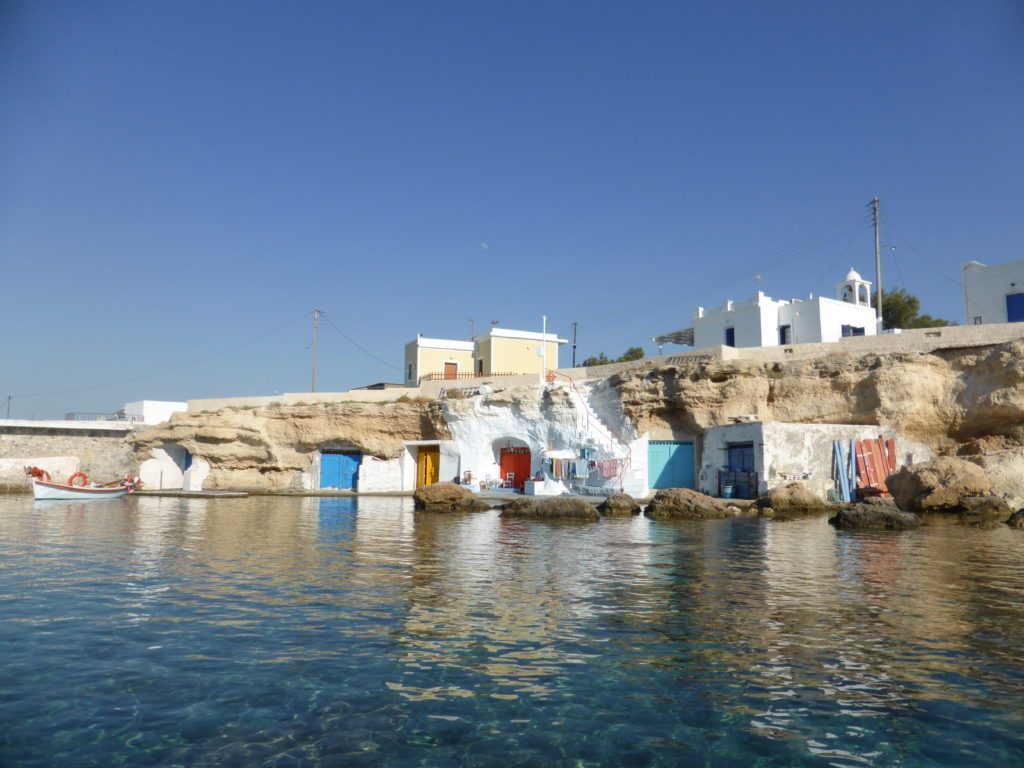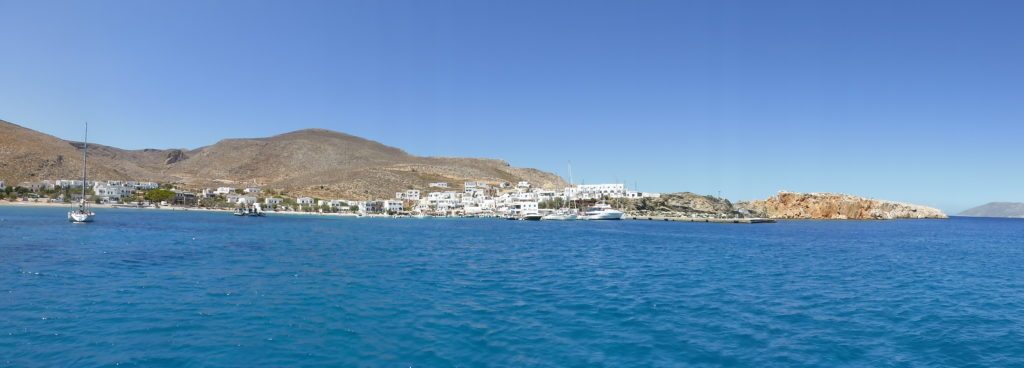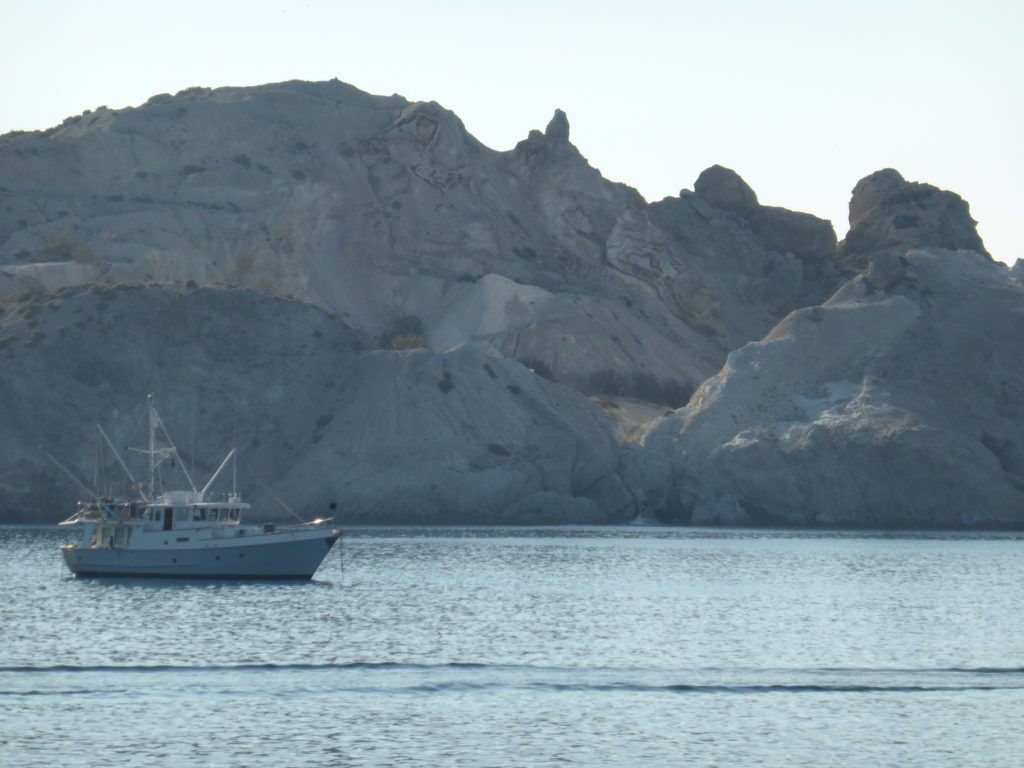In southern Greece with Envoy moored stern-to a causeway linking Monemvasia Island to the mainland village of Yefira, we enjoy exploring the village and its small taverna-lined fishing boat harbour where we find a fresh water tap to replenish our supplies using 25 litre jerrycans carried in our dinghy. We frequently do this rather than mooring Envoy alongside in a harbour or marina to replenish her water tanks.
I need to get an earlier ear infection checked so drop in to visit Yefira’s only doctor. During a free 15 minute consultancy she confirms I’m ok and advises putting drops of pure alcohol in my ears if they get wet while swimming. This causes Diane to chortle merrily and tell the doctor she thinks I’ve generally got enough alcohol in my body without adding more.
Cruising to Milos Island in the Central Aegean Sea
At Monemvasia we have strong northerlies gusting 30 knots and the breaking seas outside our protected mooring area are over two metres high – not what we want for a 60 mile easterly crossing to Milos Island with no shelter in between. But we see a weather break coming with the wind forecast 14 knots gusting 20, so having removed our stern lines the night before to aid a speedy departure we leave Monemvasia at 0700. Thirteen hours later we pull into the welcome shelter of Ormos Provatas on the southern side of Milos Island. This is a relatively long trip for us, steering one course the whole way in seas up to one and a half metres breaking on our port beam. Our Naiad hydraulic stabilisers do their job perfectly, providing a comfortable trip and reducing roll to about 5 degrees, sometimes 10 in the bigger waves.

We’re often surprised how few other boats we encounter and on this trip see only one yacht, one fishing boat and three large cargo ships. We have to change course to avoid one of these ships approaching from starboard and here’s a typical sequence of events when we identify a vessel on a possible collision course:
-I notice a distant vessel on the starboard horizon and use the binoculars to identify it as a tanker.
-Activating the radar I see it is 12.3 miles away and heading generally towards us.
-I adjust the radar’s Electronic Bearing Line (EBL) so that it lies over the tanker and do the same with the Variable Range Marker (VRM).
-The EBL shows the bearing of the tanker from Envoy and if this remains constant we are on a collision course. If the tanker moves ahead of or behind the EBL by a safe distance no course change is needed.
-The VRM shows the exact distance from the tanker to us.
-The tanker is getting closer on a converging course so we turn 30 degrees to starboard enabling the tanker to see our evasive action and pass safely across our bow.
Avoiding this tanker is easy but dealing with several approaching vessels can be stressful, especially at night.
Apart from keeping watch we do hourly checks recording engine temperature, oil pressure, battery charging voltage and AC and DC amps being drawn as well as a quick visual inspection of the engine room to detect any unusual smells, leaking hoses, fluids under the engine, suspect vee belts or water in the bilges.
We also use this relatively lengthy cruise to confirm our fuel consumption which works out at just over eight litres per hour running between 1530 and 1640 rpm including three hours of generator use.
Milos Island
Ormos Provata is a great bay providing near perfect shelter from 20 to 30 knot northerly winds for the next three days. The seas are sufficiently rough that smaller local ferries and day tripper boats are canceled, but the bay is well-protected and people ashore enjoy the sandy beach and nearby tavernas. Envoy is anchored about 300 metres offshore where the strong wind raises a small chop so we take our RHIB to calmer inshore water for our swims.
When the wind and seas abate we cruise to the northern side of the island noting that the rugged coastline indented with many sea caves has been ravaged by mining. In fact the first settlers came here in Neolithic times (7,000 BC) in search of glass-like obsidian to make axes, knives and adzes. During the later Bronze Age (about 2,800 to 1,100 BC) Milos became a prosperous centre of Cycladic culture based on minerals.

Milos is a volcanic island and we anchor off its main town, Adhamas, on the shores of a huge bay formed by an eruption in 90,000 BC. Adhamas is stunning with whitewashed buildings on the bustling taverna-lined seafront, some interesting shops and excellent facilities to re-supply.
We take a bus to the summit of some steep hills behind Adhamas where the Chora (hilltop village) offers superb views over the island. Milos is best known for its 4th century BC armless statue of Aphrodite – the Venus di Milo found by a farmer in an olive grove in 1820 and now exhibited in Paris.
With the wind forecast to turn to a rare 20 knot south-westerly (it’s mostly from the north) we cruise to shelter on the northern side of Milos island finding a delightful anchorage at Mandrakia. In total contrast to Adhamas this is just a secluded bay with several holiday villas and one atmospheric taverna ashore overlooking a gorgeous small harbour surrounded by rustic holiday homes, mostly built into sea caves. Ashore we enjoy the spectacular view and a cold beer or two.
The southerly change is only for one night and next day it’s back to strong northerlies again, so we cruise about an hour to anchor off Psathi on the island of Nisos Kimolos. We’re the only boat anchored in this interesting, quiet spot with a small hospitable village to explore.
Again we take a bus to visit the hilltop Chora but find it disappointing – maybe we’ve seen a few too many of these.
Folegandros and Sikinos Islands
Still heading east we cruise to Karavostasi on the dry, barren island of Folegandros. The uncrowded anchorage is picturesque and we take a wander ashore followed by a cold beer in a quaint beachside taverna – now there’s a familiar story!
The winds from the north have been exceptionally strong for the last few weeks and dictate our daily planning to a great extent. Here in Folegandros it has been sheltered with the wind coming from the north-west but now it moves to direct north and even this small change of direction sends an uncomfortable swell into our confined anchorage causing several boats to depart followed shortly by us as we head for the island of Sikinos. The wind is now gusting 25 knots with the seas much rougher than we expect – two to three metres high, closely spaced and breaking. We’re towing our RHIB and Diane says she has never seen it riding on wavetops that much higher than Envoy before. The stabilisers are finding it hard to cope with the breaking seas exactly beam-on and a few things fall out of their storage positions – something that rarely happens aboard Envoy, so we alter course away from our present direct line to our destination and take the seas at an angle of about 25 degrees to the beam, noticing an immediate and welcome improvement. These are not the conditions in which we’d want anything to go wrong or to have nervous guests aboard.
I haven’t put my finger on the reason why, but the seas in the Med are more vicious than one would expect for any given wind strength, a fact confirmed by many cruisers.

We’re glad to reach the lee of Sikinos and anchor off the only shelter the island offers – Skala Sikinos. We’re the only boat here and the small peaceful village is great to wander around, however the anchorage is very small and close to a ferry turning area. Shortly after midnight I’m awoken by the sound of throbbing engines and a rattling anchor chain and go on deck to be blinded by the beam of a searchlight shining down from the bow of a ferry about 10 metres above me and only 20 metres away. Fortunately these ferry captains know what they’re doing, but it’s a bit nerve-wracking and after the same thing happens soon after daylight when a ferry crew member politely hails down to us that we should re-anchor further from the jetty we decide to move on as space is limited here.
Ios Island and The Howling
From Sikinos it’s just five miles east to Ios Island, inhabited for thousands of years by Macedonians, Ionians, Greeks, Romans, Byzantine crusaders and Venetians – interspersed with pirates.
We anchor in a large sandy bay called Ormos Milopotamou offering near perfect shelter from the forecast 25-35 knot winds, but find it’s a real tourist mecca with hordes of sun-worshipers decorating the beach, high-powered motor boats towing banana boats around the anchorage and tavernas belting out loud monotonous music – anything but quiet. Ashore we seem like the oldest people here with mostly younger people enjoying what Lonely Planet describes as “packaged Hedonism”. The sports boats travel at high speeds dangerously close to swimmers and other boats as their drivers give friendly waves, but nobody seems to care – it seems here in Greece rules are made to be broken.
Ashore there’s plenty of places to re-stock provisions and there’s a bus service to the hilltop Chora, which is sizable and interesting with the usual narrow cobbled lanes lined with colourful shops, cafes and tavernas. Ios is noted as a nudist mecca but we don’t see any evidence of this.
Below the Chora on the island’s north-western side is the ferry port, also lined with quaint tavernas and although this harbour has great shelter, yachts are not allowed to anchor here as large ferries need the turning space.

Just one hour’s cruise south is the more remote and quieter bay of Ormos Manganari where we spend the next few days sitting out the Meltemi (strong northerly wind). The wind is so strong that we see sandstorms on the beach and sheets of spray lifted off the sea. During the worst squalls it’s too dangerous to venture ashore in our RHIB and we see one yacht’s outboard-powered RHIB flip upside down in the strong wind (this is common so never leave an outboard on a small tender in the water during strong winds). Later the yacht’s crew attempt to paddle their dinghy ashore but are unable to make headway and get driven downwind prompting Diane and I to leap into our RHIB and rescue them.
The wind just doesn’t drop, in fact for 20 days out of 22 we have winds well into the 20 knots, gusting into the mid 40s and we’re long over the howling noise the wind generates from about 15 knots upwards.
Envoy has excellent ground tackle so dragging our anchor isn’t an issue, but we have to keep a close watch on other boats, particularly charter yachts anchored close by in case they drag onto us.
Envoy Tech-Talk
Replacing incandescent and halogen lights with LED lights is a topical subject in many boating and technical magazines. Until recently it has been necessary to replace the light fitting to use LED bulbs, but now LED drop-in replacements are available for most types of conventional bulbs. LED lights use less power, last longer and generate less heat, but they are more expensive and their light is not as “warm-looking” as conventional lights (although this situation is improving). Incidentally LED bulbs are not rated in watts like conventional bulbs, but in lumens (lm) – a measure of its light produced.
Envoy has mostly halogen lights and we conduct an exercise in replacing a bulb with an LED in a light above our galley sink where the amount of heat generated by the present bulb is excessive. We buy a Chinese-made “Dixplay” brand bulb and it fits the socket with no problem. The cost is 10.80 Euros (about NZ$16) compared with 2.50 Euros (about NZ$4) for a standard bulb. This purchase is made at a chandler so both bulbs would becheaper in a specialist lighting shop. The result is that the light is bright enough, is not excessively bluish and does solve the heat issue – but would we use LEDs generally? No. LEDs are great for an application where power saving is all-important, for example in a boat with no generator or a freedom caravan. But aboard Envoy we generally run the engine for several hours daily as well as the generator for two to three hours (to power the refrigerator) so electrical power and battery charge is not an issue. We also have many spare conventional bulbs aboard so cannot see any advantage in paying the considerable additional cost to move to LEDs.




